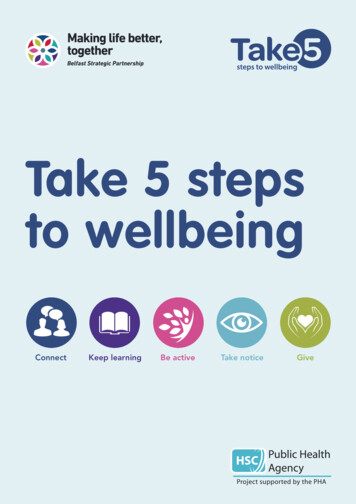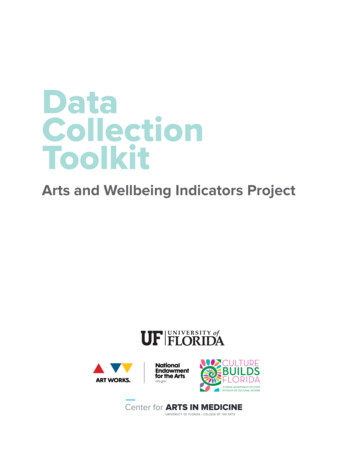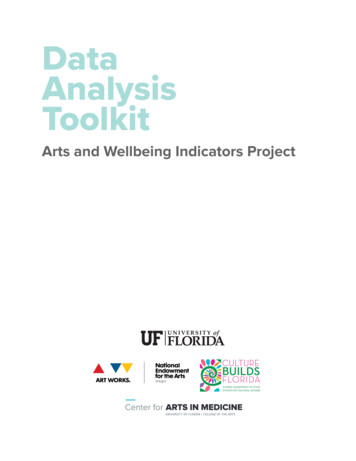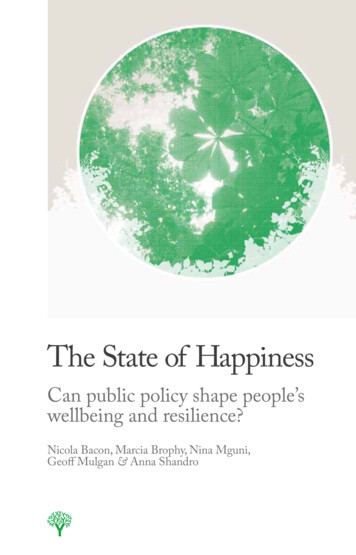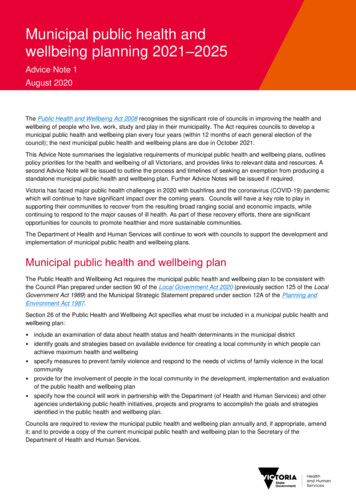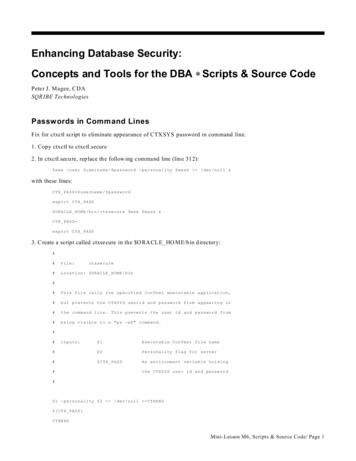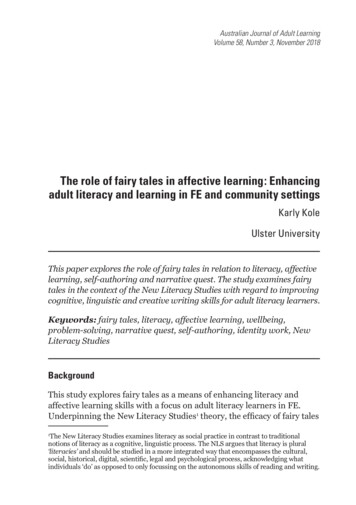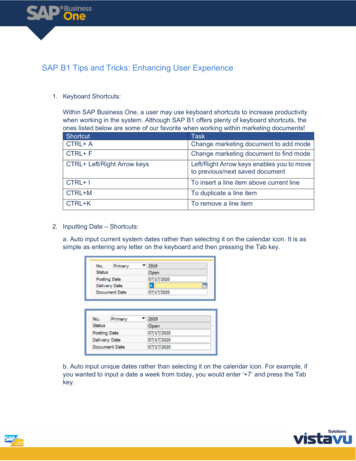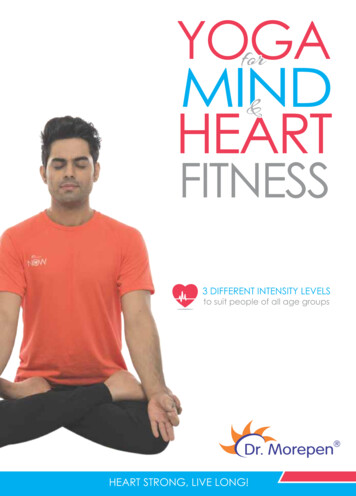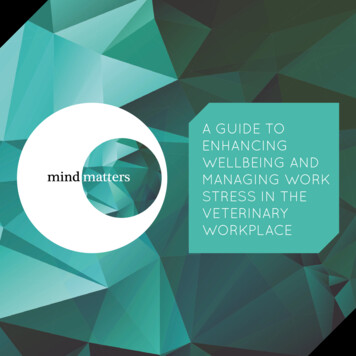
Transcription
A GUIDE TOENHANCINGWELLBEING ANDMANAGING WORKSTRESS IN THEVETERINARYWORKPLACE
INTRODUCTIONTO THE GUIDEPsychological wellbeing at work is afocus of attention for the veterinaryprofession. In particular, we recognisethe importance of addressing workrelated stress to protect the wellbeingof the veterinary team. Work stresscan affect physical and psychologicalhealth, and can also lead to poorerwork performance, increasedabsenteeism and employee turnover.The ethical and business reasons fortackling work stress are clear.This guide provides advice to veterinaryworkplaces, including clinical practicesand other settings in which veterinaryprofessionals work, on approaches tomanaging stress and promoting wellbeing. Itis designed for everyone who has an interestin the wellbeing of the veterinary team, inparticular practice managers, line managersor health and safety officers.The guide begins by outlining the root causesof work-related stress and the reasons whyit should be addressed. We then describea range of approaches to managing stressat work, and provide some suggestions forhow these might be applied in veterinaryworkplaces. The guide finishes with advice onhow to maximise the effectiveness of stressmanagement initiatives in the workplace.The guide has been developed by Dr ElinorO’Connor, Senior Lecturer in OccupationalPsychology at Alliance ManchesterBusiness School, University of Manchester,in association with the Royal College ofVeterinary Surgeons’ (RCVS) Mind MattersInitiative (MMI), and is illustrated withexamples from the three winning practices ofthe 2016 MMI/Society of Practising VeterinarySurgeons Wellbeing Awards: 387 VeterinaryCentre (Small Practice Category), Valley Vets(Medium Practice Category), and White CrossVets (Large Practice Category). We hope thatyou will find the guide helpful for identifyingsteps to support wellbeing in your workplace.We would welcome your feedback on the guide, aswell as examples of how your workplace supportswellbeing and seeks to tackle stress in veterinarywork. Please email Lizzie Lockett atlizzie@vetmindmatters.org with your comments.2
WHAT ISWORKSTRESS?“Common stressorsinclude highworkload, limitedcontrol at work,and conflictingdemands or unclearperformanceexpectations”Well-organised work and a good workingenvironment are beneficial for ourwellbeing. However, even for thosewho normally enjoy their work, everyjob involves difficulties or less pleasantexperiences at times. Stress occurs whenthe person feels that work demandsexceed their capacity to deal with thesituation.Stress differs from work demands thatwe experience as challenging, but withwhich we believe we can cope; in fact,3these challenges can be motivating andhelp us to achieve our goals.Sources of stress vary across differentprofessions and occupations, butcommon stressors include high workload,limited control at work, and conflictingdemands or unclear performanceexpectations. In addition, our personalitycharacteristics and coping style influencehow we respond to demanding situationsat work and, in turn, the degree of stresswe experience.
WHY SHOULDWORK STRESSBE ADDRESSED?An RCVS survey of veterinary surgeons foundthat almost 90% reported that veterinarywork is stressful (Institute for EmploymentStudies, 2014). Frequent or prolongedexposure to stressful situations at work canaffect physical and psychological health andreduce job satisfaction and commitment. Inthe UK, stress is the second-largest cause ofwork-related ill-health diagnosed by generalpractitioners (Health and Safety Executive(HSE), 2016).Effective stress management not only hasbenefits for workers’ health and wellbeing, butthere is also a clear business case for reducingstress. Work stress is associated with reducedperformance and productivity, increasedabsenteeism, and higher employee turnover.In 2015-16, 11.7 million working days in the UKwere lost to work-related stress (HSE, 2016).In addition, employers have a legal duty underthe Health and Safety at Work Act (1974) andthe Management of Health and Safety at WorkRegulations (1999) to protect the health andwelfare of workers, which includes managinghazards to psychological health.HOW CANWORK STRESSBE MANAGED?Techniques for managing work-relatedstress have either an organisational focus,involving changes to the workplace or workingpractices to target sources of stress, or anindividual focus, which involves strengtheningpeople’s resilience to stress. It is also useful tothink about stress-management interventionsin terms of what they seek to achieve. Someinterventions aim to remove or reduce thecause of stress, some seek to reduce theimpact of stress on the person, and someseek to support and rehabilitate peopleexperiencing stress-related ill-health.In practice, the interventions most often usedfor managing work stress are individual-leveltechniques, and research evidence supportstheir effectiveness. Organisational-levelinterventions can also be effective. However,there are relatively few ‘off-the-shelf’ versionsof organisational-level interventions; theseinterventions usually have to be tailored toeach specific workplace.Finding solutions to work-related stress mightseem challenging, however, in this guide, we4All staff at 387 Vets were askedto take personality tests, helpingthem to engage effectively andcalmly with their colleaguesaim to describe some of the key principlesfor managing work stress, and make somesuggestions for how you might apply them inyour workplace.Individual-level interventionsIndividual-level interventions are designedto help people increase their resilience andto cope with stress at work. Some examplesinclude mindfulness programmes, relaxationtechniques, and training in specific skills suchas time management. Mindfulness is increasingly being used asa technique for managing work-relatedstress. Research shows that mindfulnessimproves psychological wellbeing andreduces feelings of stress. The MMImindfulness-based stress managementprogramme is available fromwww.thewebinarvet.com. Other courses
and structured programmes are available,including apps such as Headspace; Relaxation techniques for reducing stressinclude muscle relaxation and controlledbreathing techniques. These techniquesare straightforward to use, and researchindicates that they can be effective inreducing feelings of stress; Healthier lifestyle programmes thatsupport exercise and better diet can alsohelp with stress management and improvepsychological wellbeing, such as the NHS’sFive Steps to Mental Wellbeing guidance at:www.nhs.uk/wellbeingFor people experiencing prolonged or intenselevels of stress, or who are experiencingstress-related ill-health, additional supportmeasures can be helpful. Employee assistance programmes providesupport and counselling for personal orwork-related difficulties. For example,Vetlife offers free and confidential adviceand support to veterinary professionals ona range of issues, including work-relatedstress and mental health concerns www.vetlife.org.uk Sickness absence support and returnto-work schemes are recommended formanaging long-term sickness absencewhether due to physical or psychological illhealth (long-term absence is usually definedas continuous absence for four weeks ormore). Guidance on managing sicknessAn RCVS survey of veterinary surgeonsfound that almost 90% reported thatveterinary work is stressful(Institute for Employment Studies, 2014)Organisational-level interventionsOrganisational interventions aim to changethe workplace or work practices to removeor reduce sources of stress at work. In thissection, we describe some of the main sourcesof stress at work and offer suggestions on howthey can be lessened.High workloadHigh workload, including unpredictablesurges in workload from day to day, is acommon feature of veterinary work. Animportant step in managing workload isto obtain accurate estimates of typicaldaily workload levels, including workloadduring peak and emergency periods, andto consider if the amount and pace of workare appropriate and whether staffing levelsare sufficient. Key principles for managingworkload are:Workload and work/life balanceVeterinary work can involve high workload,long working days, and working unsocialhours, including on-call working, all of whichcan affect wellbeing. Scheduling a variety of tasks with differingphysical or mental demands during theworking day can help to maintain people’salertness and reduce fatigue; It is best if demanding tasks are scheduledabsence is available from the CharteredInstitute of Personnel and Development /absence/factsheet5
when people are less likely to be fatigued,for example, try to avoid scheduling themat the end of the working day, although itis appreciated that emergencies will comewhen they come; If possible, enable people to have a sayin scheduling their duties, for example,attending consulting and operating periods; Encourage regular breaks during theworking day and ensure that there arefacilities for breaks to be taken away fromthe immediate place of work, ideally awayfrom ringing phones or allowing a chance forsome fresh air; Monitor individual colleagues’ workloadat regular intervals and revise their workallocation if appropriate.In managing the impact of workload, it isimportant to consider not only staff numbers,but also the mix of experience and skillsrequired to meet workload demands. An HSEguide on ensuring appropriate staffing levels,including advice on managing in circumstancesof reduced staffing, is available at: .htmWorking unsocial hours, includingon-call working‘Shift working’ is defined as on-call duties,work that is scheduled outside the hours of07.00-19.00h, work periods of 12 hours ormore, or rotating hours of work. Shift work,particularly where it involves early morningstarts or working at night, can lead to fatigue,“In managing theimpact of workload,it is important toconsider not only staffnumbers, but also themix of experience andskills required to meetworkload demands”White Cross Vets have theirown currency system, the ‘Alfie’,letting colleagues thank orcongratulate each other on aparticularly good jobreliance on sedatives or stimulants, disruptionof domestic and social life, and poorer workperformance. Some good-practice guidelinesfor the design of work schedules that may behelpful for veterinary work are: When work demands concentration, issafety critical, or involves exposure tophysical hazards to workers’ health, it ispreferable for shifts not to exceed eighthours; Ensure work schedules permit a minimumof 11 hours off between the end of oneshift and the start of the next; Ensure schedules allow adequate rest timefor those undertaking on-call duties. This is6White Cross Vets contributes to allof their team’s gym membershipsand Fitbits, and even createda White Cross Fitbit group toencourage participation
particularly important during periods whencall-outs are more likely, such as lambing andcalving; If possible, avoid ‘split’ shifts, as they tend tolengthen the working day; When people are switching from day to nightworking or vice versa, ensure that their workschedule incorporates a minimum of twonights’ full sleep; If colleagues commonly ‘shift swap’, it isrecommended that details are recorded andmonitored to ensure that it is not resulting ininsufficient rest time and increased fatigue.A useful HSE guide for organisations ondesigning work schedules is available at:www.hse.gov.uk/pubns/priced/hsg256.pdfWork demands and job conditionsBy its nature, veterinary work involves anumber of features that are potentiallystressful, such as exposure to animalsuffering, cases in which challengingcomplications occur, working with clientswho may be upset or distressed, and loneworking.Where possible, changes to the workplaceor working practices to remove or reducerisk associated with these demands arerecommended (for example, protocols forlone working). In the case of stressful featuresof veterinary work that are unavoidableor difficult to target, such as exposure toanimal suffering, it is appropriate to considerIn the UK, stress is thesecond-largest cause ofwork-related ill-healthdiagnosed by generalpractitioners(Health and Safety Executive, 2016)techniques for helping colleagues cope withthese, such as specific training programmes(for example, dealing with compassionfatigue) or more general stress managementmethods (for example, mindfulness training).Working with clientsAny job that involves interaction with clientscan, at times, require workers to deal with7emotional, demanding or discourteouspeople. In veterinary work, potential clientrelated stressors can include animal owners’high expectations of vets and vet nurses,complaints, and exposure to verbal abuse orthreatening behaviour. Training in working with clients can bebeneficial for members of the veterinary
team who deal directly with clients, anda range of specialist training coursesfor working with veterinary clients areavailable; With regard to managing abusive andthreatening behaviour specifically,guidance developed by the HSE can befound at: www.hse.gov.uk/violence/toolkit/customers.htm and: ment.pdf Consideration could be given to a singlepoint of contact for the handling ofcomplaints.Lone workingLone working includes circumstances inwhich a person works alone at their usualworkplace (for example, during out-of-hourswork) or at other locations (for example,undertaking house calls and farm visits). A HSE guide on assessing and managinglone-working risk is available at: www.hse.gov.uk/pubns/indg73.pdf Information about lone-worker safetyprotocols and devices, and training formanagers and lone workers on reducinglone-working risks are available from the SuzyLamplugh Trust: www.suzylamplugh.orgWork relationshipsLack of social support and difficulties or conflictin relationships at work can be significantsources of stress at work. Key principles for 387 Vets provided compassionand bereavement training forthe whole teammanaging relationships at work are: Fostering positive relationships and socialsupport not only removes or reducesa potential source of stress in its ownright, but can also help people to copewith other aspects of their work that arestressful; Mentoring schemes and peer supportgroups can be helpful for developing socialsupport within the team; Informal approaches to fostering socialsupport can be effective; these are basedon creating opportunities for peopleto spend time together and to developrelationships with each other. Forexample, ensuring that people can take8 breaks together during the working dayenables them to be a source of supportfor each other;Social events outside working hourscan also foster positive relationships.However, try to ensure that people whomight prefer not to participate do notfeel obliged to attend. Similarly, considera range of social activities, for example,events that are alcohol or food-basedmight not be appropriate for everyone;It is helpful to have in place measures foridentifying and resolving difficulties orconflict in relationships at work and toensure that people are aware of these.For managers, dealing with conflict inrelationships at work can be challenging –and stressful – and specific training in thismay be helpful;With regard to harassment and bullyingspecifically, it is helpful to have aclear policy stating that these are notacceptable and outlining how allegations ofunacceptable behaviour will be managed.Useful guidance on reducing the risk ofbullying and harassment, as well as dealingwith them when they do occur, is availablefrom the Advisory, Conciliation andArbitration Service: www.acas.org.uk;It is important to create an open andlearning culture where team members feelthey can discuss things that have not gonewell in a non-judgemental environment,and the whole team can develop andimprove systems as a result.
Valley Vets vary their outingsas a team, arranging for groupcinema viewings, speed boatoutings, and summer barbequesPersonal and career developmentUnclear performance expectations, ‘roleconflict’, and concerns about careerdevelopment are potential sources of stress atwork. Key principles for addressing these are: Ensure that people know what isexpected of them at work in terms oftheir responsibilities and the standards ofperformance required; Provide constructive feedback aboutperformance. Feedback is most effectivewhen it is timely and appropriately frequent(providing feedback only during an annualperformance review might not be sufficient); Be aware of and address potentialIn 2015-16, 11.7 million working days inthe UK were lost to work-related stress(Health and Safety Executive, 2016)role conflict; this can include conflictbetween the person’s capabilities andthe requirements of their role, orconflicting demands arising from differentresponsibilities within their role; Mentoring and supervision are beneficialnot just for recently-qualified or newcolleagues, but may also be helpful for9those taking on new roles at more seniorlevels or returning to work after a periodof absence. In addition, mentoring can begood for the wellbeing of the mentor aswell as the person being mentored; Veterinary workplaces usually fund andprovide leave for continuing professionaldevelopment (CPD), but it is important to
be aware of and address potential barriersto people undertaking CPD, such as highworkload.Control at workNot having enough control over workmatters is a common source of stress. Keyprinciples for addressing this are: There are unavoidable constraints on howveterinary work is undertaken, but enablingpeople where possible to be involved indecisions about how work is organised andcarried out is beneficial to wellbeing; Good communication is fundamentalto people having a sense of control atwork. It is helpful to have a number ofcommunication channels in place, forexample, meetings, newsletters, suggestionschemes etc. It is important that peopleare kept informed of what is happening atwork, but communication should not justbe ‘top-down’ from those in managementpositions; ensure that everyone is able tohave a say; Change at work can be unsettling. Inthe event of change taking place, it isimportant to give people opportunitiesto ask questions and comment on what ishappening; Team working can enable people tocontribute to decision making. Forexample, when new projects arise, it ishelpful if they are undertaken by groupsrather than single individuals.MAXIMISING THEEFFECTIVENESSOF STRESSMANAGEMENTINITIATIVESResearch has identified a number of factorskey to the effectiveness of work stressmanagement initiatives: Stress management is most effectivewhen it is tailored to the specificorganisation. This means identifyingthe sources of stress in your work,establishing who in the team might beaffected by them, and deciding whatapproaches to targeting stress are mostappropriate for your workplace; It can be helpful to use a number ofstress management initiatives – perhaps amix of organisational-level interventionsor a combination of organisational- andindividual-level approaches; Senior and middle management supportfor the importance of wellbeing at10Following an avoidable patientdeath at Valley Vets, the practicemanager visited all branch sites todiscuss the rationale for a changein procedureswork is key to ensuring that stressmanagement initiatives are appropriatelyresourced and are implemented; Similarly, stress management measuresare most likely to be effective whenall colleagues have an opportunity tocontribute to the planning, development,implementation and evaluation ofwellbeing initiatives. A participativeapproach to stress management helpspeople feel involved, which can have apositive effect on wellbeing in its ownright, and also increases the likelihoodof the initiatives being accepted by allmembers of the team.
ADDITIONALRESOURCESSOME FINALTHOUGHTSIn addition to the sources of further advice listed throughoutthis guide, useful general resources relating to stressmanagement and psychological wellbeing at work include: The Health and Safety Executive provides a comprehensiveguide to assessing and managing stress at work:www.hse.gov.uk/stress/standards The mental health charity, Mind, provides guidance onsupporting work colleagues who have mental sources/ The RCVS Mind Matters Initiative website has details ofresources, including training courses, to support wellbeingin the veterinary profession:www.vetmindmatters.org The charity Vetlife offers a confidential, 24/7 Helplinewhich is available to any member of the veterinary team,and a Health Support Service:www.vetlife.org.uk The SPVS/MMI Wellbeing Awards website includes usefulcase studies and tips: www.vetwellbeingawards.org.ukTo reduce stress and promote wellbeing at work, youdo not need to implement all of the suggestions inthis guide. Indeed, just one or two simple initiativesto support wellbeing at work can make a difference topsychological health.A good example we have come across is a small animalpractice that makes sure that the team has a sharedlunchtime. Not only does this give colleagues a chance fora break and some food during the long working day, but italso enables them to offer a listening ear and be a source ofsupport and advice for each other.We hope this guide is helpful in identifying steps forsupporting wellbeing and reducing stress in yourworkplace.11
The Mind Matters Initiative is run by the Royal College of Veterinary e@vetmindmatters.org
the UK, stress is the second-largest cause of work-related ill-health diagnosed by general practitioners (Health and Safety Executive (HSE), 2016). Effective stress management not only has benefits for workers’ health and wellbeing, but there is also a clear business case for reducing stress
